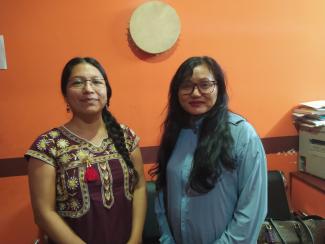Voices from the Himalayas: Tamang Women’s Action to Combat Human Trafficking
11 Oktober 2023agnes
Wed, 10/11/2023 – 09:20

By Gerard Beelt Tiwow (CS intern)
October 11 is International Day of the Girl Child, which presents an opportunity to highlight how Indigenous women and girls are disproportionately affected by human trafficking and sexual exploitation in Nepal.
Statistics and media reports indicate that Tamang women and girls from the Tamang Indigenous community in the adjoining districts of Kathmandu Valley constitute a significant majority of the victims of trafficking and exploitation. Historically, Tamang women were coerced into serving as courtesans and concubines to rulers in Kathmandu. This vulnerability has persisted to the present day, leading to a large number of Tamang women becoming victims of sex trafficking to India and elsewhere.
Statistics vary, but according to Shakti Samuha, a Nepali organization that supports survivors of sex trafficking, approximately seven out of every 10 girls who fall victim to sex trafficking are from Indigenous communities. The trafficking of women and girls in Nepal is primarily attributed to factors such as illiteracy, unemployment, poverty, natural disasters, and political instability, among other related issues.
Tamang women and girls are particularly vulnerable to sex trafficking due to poverty, and are frequently lured by the promise of job opportunities or better living conditions in the city. Addressing poverty is crucial to protecting the Tamang community and combating human trafficking effectively in Nepal.
Nepal Tamang Women Ghedung, a Nepali Indigenous women’s organization, identified the need to organize a series of interactive programs or communal gatherings locally and to form anti-trafficking groups that raise awareness and empower Tamang Indigenous women on the issues of trafficking and exploitation.
In 2019, Nepal Tamang Women Ghedung, in partnership with Cultural Survival through the Keepers of the Earth Fund, initiated a project to organize workshops in the districts of Kavre, Sindhupalchowk, and Makawanpurwith for Tamang Indigenous women. Around 140 women participated in the programs, which also involved district-level government officials and NGOs with the intention of making them accountable for the trafficking issues.
Nepal Tamang Women Ghedung recognizes that trafficking and exploitation threaten the physical safety of Indigenous women while eroding the cultural values of the community. By safeguarding Tamang women from trafficking, the project upholds the dignity and integrity of the community’s centuries-old heritage and traditions and creates a safer environment for Tamang women and girls by providing them with the knowledge and tools to protect themselves. A safer environment, in turn, encourages women to pursue education, access economic opportunities, and actively participate in decision-making processes within their families and communities.
Involving district-level government officials and NGOs in the interactive programs enhances accountability and coordination in the fight against trafficking. By engaging these stakeholders, the project seeks to instigate tangible changes in policies and resource allocation to address trafficking effectively. This multi-stakeholder approach acknowledges that combating trafficking requires collaborative efforts from all sectors of society.
Nepal Tamang Women Ghedung is aware of the power of collective action and seeks to harness this power by forming anti-trafficking women’s groups in each district. These groups serve as a network of support, encouraging members to actively report trafficking incidents and provide assistance to victims. Their project not only aimed to protect Tamang women from trafficking but also strives to empower them to be advocates for change within their communities.
To ensure that the project’s impact would be far-reaching, Nepal Tamang Women Ghedung engaged media outlets to cover the workshops and raise public awareness about trafficking issues. The media can play a crucial role in shaping public perception and fostering a more empathetic and proactive society by shedding light on the realities faced by Tamang women and girls.
By the end of the project’s timeline, Nepal Tamang Women Ghedung envisions a transformed societal awareness in Kavre, Sindhupalchowk, and Makawanpur districts, where Tamang women will be equipped with the awareness and confidence to combat trafficking.
Approximately 500 Tamang Indigenous women directly benefited from the project’s interventions, and an estimated 300,000 women living in these districts indirectly benefited from increased awareness. Nepal Tamang Women Ghedung plans to establish a framework to sustain the project’s impact beyond its official timeline.
Nepal Tamang Women Ghedung’s project to combat trafficking among Tamang Indigenous women is a comprehensive and community-driven initiative. By addressing the root causes of vulnerability, raising awareness, and empowering women, the project has the potential to break the cycle of exploitation and protect the dignity and rights of thousands of Tamang women and girls.
The dedication of the organization, coupled with the involvement of diverse stakeholders, promises a brighter and safer future for Indigenous women in Kavre, Sindhupalchowk, and Makawanpur districts. As the project unfolds, it is poised to serve as a shining example of collective action and empowerment for the betterment of vulnerable communities across Nepal.
In 2019, Nepal Tamang Women Ghedung received a Keepers of the Earth Fund (KOEF) grant to support their work. KOEF is an Indigenous-led fund within Cultural Survival designed to support the advocacy and community development projects of Indigenous Peoples. Since 2017, KOEF has funded 310 projects in 41 countries through small grants totaling $1,603,307, as well as provided technical assistance benefiting 328 Indigenous Peoples. KOEF provides grassroots Indigenous-led communities, organizations, and traditional governments to support their self-determined development projects based on their Indigenous values. Predicated on the United Nations Declaration on the Rights of Indigenous Peoples, Cultural Survival uses a rights-based approach in our grantmaking strategies to support Indigenous grassroots solutions through the equitable distribution of resources to Indigenous communities.
